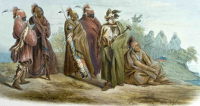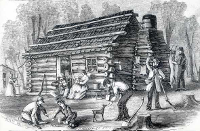The Making of the 50 States: Missouri
Part 1: In the Beginning Like other Midwestern states, Missouri was early populated by the Mound Builders, a Native American culture known for their ceremonial and burial mounds. Echoes of the Woodland and Great Plains cultures can be found as well. Later Native American tribes living in what is now Missouri included the Caddo, Dakota, Delaware, Fox, Illinois, Iowa, Kickapoo, Missouri, Omaha, Osage, Otoe, Sauk, and Shawnee. Crops grown included beans, corns, and squash. The tribes also hunted buffalo and deer for food. 
Spain's Hernando de Soto visited the area in 1541. French explorers Father Jacques Marquette and Louis Jolliet, on their 1673 voyage down the Mississippi River, were the first Europeans known to have visited what is now Missouri. Another Frenchman, René-Robert Cavelier de La Salle, visited in 1682 and, as he had in other nearby states, claimed all of it for France. It wasn't until 1750 that the first permanent European settlement, Ste. Genevieve, was built. St. Louis, now Missouri's largest city, was established in 1764, by the French merchant Pierre Laclede. French trappers soon had a lucrative fur trade. Louis Blanchette established the city of St. Charles as a trading post in 1769. France ceded Missouri to Spain in 1762 and regained control in 1800. During this period of Spanish control, the Missouri area was a focus for Spanish incursions against the British, particularly during the Revolutionary War. In particular, Spanish groups in St. Louis helped provision the Illinois expeditions of George Rogers Clark. Spain declared war on Great Britain in 1769, and British forces attacked St. Louis once, with little success. 
Spain welcomed American settlement in Missouri, offering land that was both free and tax-free. The population of grew in a hurry. One of the more prominent settlers was noted explorer Daniel Boone. An American officer named George Morgan, with Spanish support, set up a semi-autonomous colony called New Madrid. The colony (site of a series of powerful earthquakes in 1811 and 1812) didn't have the support of the Louisiana Territory governor and so carried on as a trading post but didn't become a city. It was, however, one of five administrative districts into which the Spanish divided Missouri in the mid-1790s. St. Louis was the largest. The others were St. Charles, Ste. Genevieve, and Cape Girardeau. Next page > The Rest of the Story > Page 1, 2
|
|
Social Studies for Kids
copyright 2002–2024
David White




